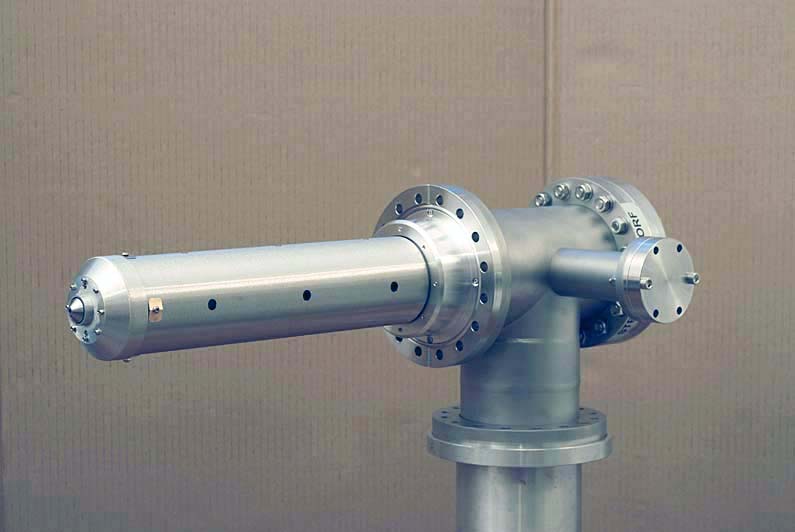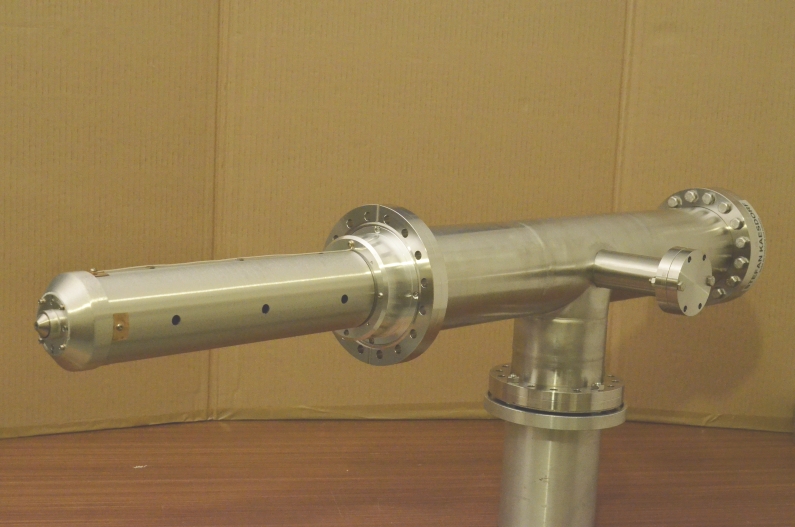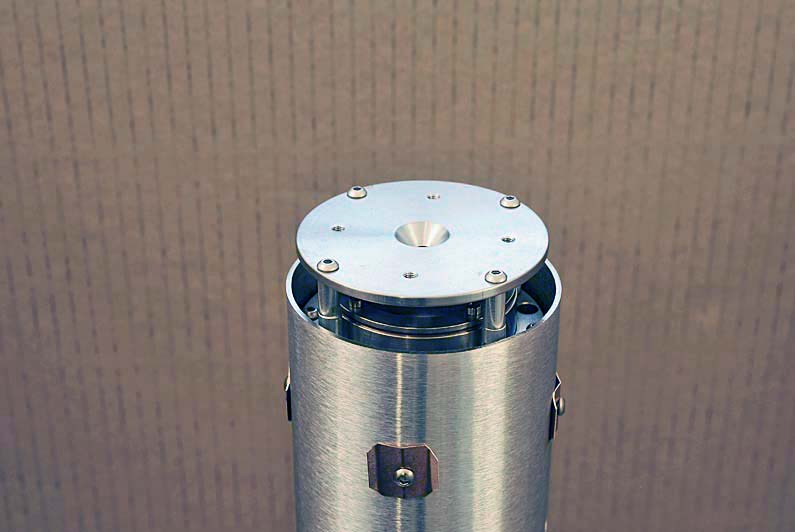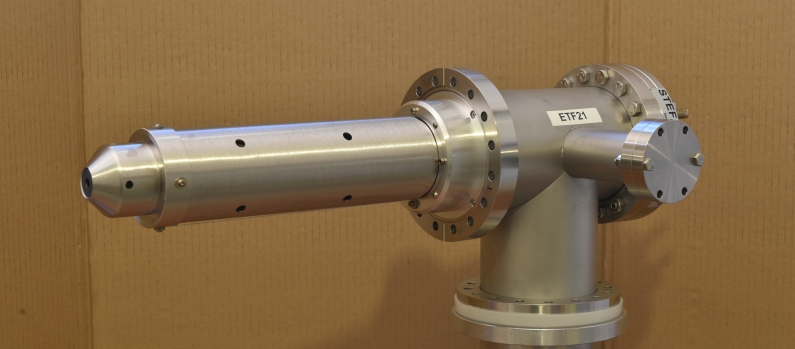Electron Time-of-Flight Spectrometers
|
|
ETF11 Electron Time-of-Flight Spectrometer
|
|
 |
|
|
|
Features:
- Minimum electron energy ca. 20 eV (depending on the magnetic fields of the environment)
- Time-of-flight resolution T/ΔT = ca. 100
- Fieldfree drift tube with 350 mm standard length, encapsulated in a µ-metal shield
- Drift tube region can be floated to positive or negative potentials:
up to –180 V for decelerating fast electrons
up to +180 V for accelerating slow electrons to reduce the effect of magnetic fields
Channelplate detector with two-stage chevron geometry, channelplates with 5 µm pore size for fast response times, 40 mm active diameter
- Post-acceleration stage in front of the detector to get a uniform sensitivity for all electrons irrespective of their kinetic energy and to reduce the effects of magnetic fields penetrating through the back flange into the µ-metal shield
- Conical entrance aperture with 3 mm diameter, the distance between the entrance aperture and the laser focus is also 3 mm. The distance between the tof connection flange and the laser focus is 354 mm (standard)
- Only completely non-magnetic materials are used for the spectrometer, most of the parts including the drift tube and all screws are made from titanium
- The electron beam entering through the entrance aperture is collimated in an extraction module, the acceptance angle (full angle) is ca. 45°. The only connection between the ionisation chamber and the tof chamber is the entrance aperture which allows to pump the tof spectrometer differentially
- The vacuum chamber of the electron spectrometer is manufactured from non-magnetic stainless steel 1.4429 (equivalent to 316 LN). It consists of a 6” o.d. conflat (CF100) connection flange, a 6” o.d. conflat (CF100) pump flange (CF100) and a 2.75” o.d. conflat flange (CF38) for pressure metering
- High voltage power supply in a 19” box, 3HE (132 mm) high, 350 mm deep
|
Options:
|
- Drift tube length other than standard length of 350 mm
- Distance between tof connection flange and laser focus other than standard length of 354 mm
- Accelerating/decelerating voltages different from standard values of +180V / -180 V, different maximal lens voltage
|

Electron TOF spectrometer ETF11 with drift tube length 700 mm
|
ETF15 Combined Electron TOF / Positive Ion Mass Spectrometer
|
|
 |
|
|
|
Features:
- The bipolar setup allows to use the spectrometer either as a electron tof spectrometer with time-of-flight resolution T/ΔT > 100 or as a sensitive time-of-flight mass spectrometer with mass resolution M/ΔM > 300
- Minimum electron energy ca. 20 eV (depending on the magnetic fields of the environment)
- Fieldfree drift tube with ca. 350 mm standard length, encapsulated in a µ-metal shield
- In “electron mode” the drift tube can be floated to positive or negative potentials:
up to –180 V for decelerating fast electrons
up to +180 V for accelerating slow electrons to reduce the effect of magnetic fields
- Channelplate detector with two-stage chevron geometry, channelplates with 5 µm pore size for fast response times, 40 mm active diameter
- Post-acceleration stage in front of the detector to get a uniform sensitivity for all electrons irrespective of their kinetic energy and to reduce the effects of magnetic fields penetrating through the back flange into the µ-metal shield
- Only completely non-magnetic materials are used for the spectrometer, most of the parts including the drift tube and all screws are made from titanium
- The electron beam entering through the entrance aperture is collimated in an extraction module, the acceptance angle (full angle) is ca. 30°. The only connection between the ionisation chamber and the tof chamber is the entrance aperture which allows to pump the tof spectrometer differentially
- The vacuum chamber of the electron spectrometer is manufactured from non-magnetic stainless steel 1.4429 (equivalent to 316 LN). It consists of a 6” o.d. conflat (CF100) connection flange, a 6” o.d. conflat (CF100) pump flange (CF100) and a 2.75” o.d. conflat flange (CF38) for pressure metering
- High voltage power supply in a 19” box, 3HE (132 mm) high, 500 mm deep. All the polarities of the high voltages are reversed with a single switch
|

Ion source of combined electron /ion tof spectrometer ETF15. In “electron mode”, the ionisation occurs under fieldfree conditions. In “mass
spectrometer mode”, the ions are created in a homogenous extraction field between repeller and extraction electrode and are subsequently
accelerated in a second acceleration stage to their pass energy (ca. 2000 eV) according to the Wiley-McLaren criterion. The laser focus is
always on ground potential to enable gas capillary inlet.
|
Options of the ETF15 spectrometer:
|
- Drift tube length other than standard length of 350 mm
- Distance between tof connection flange and laser focus other than standard length of 354 mm
|
 |
|
ETF21 High Energy Electron Time-of-Flight Spectrometer
|
|
 |
|
|
|
Features:
- The ETF21 electron tof spectrometer is optimized for electron energies > 1000 eV. Conventional electron tof spectrometers (like our model ETF11) are difficult to operate in the high energy range because the time-of-flights can get very short (< 10 ns). The ETF21 spectrometer allows to decelerate the electrons by a factor of up to 100.
- When deceleration is used only a section of the kinetic energy spectrum can be analysed because electrons with energies smaller than the deceleration potential (i.e. drift tube potential) cannot reach the detector
- Maximal deceleration voltage (drift tube potential) is -2 kV
- The divergence of the electron beam caused by the their deceleration is compensated with a deceleration module consisting of several electron-optical elements. The maximal acceptance angle of the ETF20 spectrometer is 6° (full cone, size of ionization zone < 200 µm)
- Minimum electron pass energy ca. 20 eV (depending on the magnetic fields of the environment
- Detector is floating on the drift tube potential
- The fieldfree drift zone after deceleration has a length of ca. 430 mm
- The distance laser focus – entrance aperture is 25 mm, the distance laser focus – connection flange is 354 mm.
- Channelplate detector with two-stage chevron geometry, channelplates with 5 µm pore size for fast response times, 40 mm active diameter
- The vacuum chamber of the electron spectrometer is manufactured from non-magnetic stainless steel 1.4429 (equivalent to 316 LN). It consists of a 6” o.d. conflat (CF100)connection flange, a 6” o.d. conflat (CF100) pump flange (CF100) and a 2.75” o.d. conflat flange (CF38) for pressure metering
- High voltage power supply in a 19” box, 3HE (132 mm) high, 350 mm deep. The voltages can be adjusted either with 10-turn potentiometers or via control voltages 0 - 10 V from a DA-converter
|
Option:
Maximal deceleration voltage of -5 kV or -10 kV
|
|